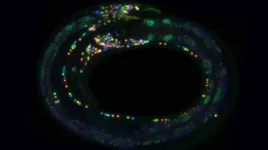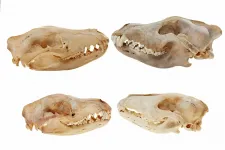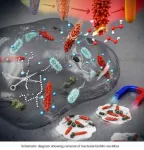(Press-News.org) A unifying explanation of the cause of autism and the reason for its rising prevalence has eluded scientists for decades, but a theoretical model published in the journal Medical Hypotheses describes the cause as a combination of socially valued traits, common in autism, and any number of co-occurring disabilities.
T.A. Meridian McDonald, PhD, a research instructor in Neurology at Vanderbilt University Medical Center, has spent 25 years researching autism, from a time she could read literally every research paper on the topic in the 1990s until now, when there is an overload of such studies.
"Up until now there have been a lot of theories about the possible causes of autism but none of those theories account for the majority of autism cases," McDonald said. "There are also a lot of theories as to why the prevalence of autism has been increasing in the population but, to date, there hasn't been a theory that provides an explanatory model that accounts for all of those phenomena, including the genetics, social history, or characteristics of autism."
The CDC estimates that 1-in-54 persons are on the autism spectrum.
Consistent with Genetics Research in Autism
McDonald's theory, titled 'The Broader Autism Phenotype Constellation-Disability Matrix Paradigm (BAPCO-DMAP) Theory,' is consistent with the current science on the genetics of autism but shifts the focus to positive traits of autism and to historical events that changed the prevalence of autism in society.
"The BAPCO-DMAP theory describes how people are attracted to other people who are very similar. They are attracted to certain traits that are very common in the population, and this leads to offspring who are more likely to have certain traits, as well as a greater intensity of traits." McDonald said.
"The (BAPCO) traits are not what people expect. They expect the traits to be about challenges or difficulties, but instead there are six main traits -- increased attention, increased memory, a preference for the object world vs. the social world and their environment, increased nonconformity, increased differences in sensory and perception, as well as systemizing."
BAPCO Can Interact with Development
BAPCO traits alone are not necessarily disabling. A person can have BAPCO traits and still have excellent communication and socialization skills, but too much of any of these traits can affect development.
For example, although it seems counterintuitive, McDonald outlines how increased memory and attention can delay language development in children with BAPCO traits.
"Typical babies have tiny attention spans and working memory. These limitations on memory and attention actually help babies learn their first language by breaking the words into their tiniest parts," she said.
"But an infant with very high levels of attention and memory has a harder time with learning language because they are unable to break the language down to very small parts, so they learn groups of sounds instead."
McDonald describes how increased memory and attention can lead to echolalia, where children speak in, or repeat, long phrases without seeming to understand them.
"You can often see children with autism engaging in sense-making activities, such as watching the same show over and over and memorizing information," she said.
BAPCO Can Interact with Disabilities
BAPCO traits can also interact with disabilities. If a person has BAPCO traits and they also have a disability such as Down syndrome or information processing disorder, then those things combined can create greater challenges than what would be experienced by an individual who has only a BAPCO personality or a disability, but not both.
Increased Prevalence of BAPCO and Autism
McDonald's theory also highlights how the prevalence of autism has increased in higher income countries due to societal changes that increase freedoms in education, employment and other opportunities for both men and women.
In societies where people do not have freedom to pursue their interests and passions, where meritorious education is not valued, where men and women do not have freedom to choose their careers, and where nonconformity is not tolerated, McDonald predicts the frequency of BAPCO traits in these populations will be very low.
"The frequency and intensity of BAPCO traits in the U.S. have increased, for example, because individuals are more likely to meet and have children with other individuals with similar education, occupations and interests than would have been possible 100 years ago," she said.
"When men and women with BAPCO traits have children it can increase both the frequency and intensity of BAPCO traits in the population."
No Cure for Autism
McDonald said she now knows what causes autism but it is not something that could be cured and, honestly, she wouldn't want to do that.
"What we call 'autism' is the BAPCO personality combined with a disability or very intense BAPCO traits," she said. "Because the BAPCO is made of socially valued traits, it is not possible to cure autism. Instead, we need to focus on the full range of disabilities that affect people with and without the BAPCO personality."
McDonald said future research should focus on the causes and treatment of underlying disabilities and also on providing supports such as interventions for individuals with disabilities, including those who have this combination of BAPCO and disability intersection.
"When we talk about autism we need to address the developmental disabilities that these individuals are experiencing but also find way to support and enhance their broader autism trait constellations," she said.
INFORMATION:
In a letter published in the December issue of the American Heart Association's medical journal Circulation a group of researchers at Vanderbilt University Medical Center (VUMC) dispute the most recent findings of the incidence of myocarditis in athletes with a history of COVID-19.
The Vanderbilt study, COVID-19 Myocardial Pathology Evaluation in AthleTEs with Cardiac Magnetic Resonance (COMPETE CMR), found a much lower degree of myocarditis in athletes than what was previously reported in other studies.
"The differences in the findings are extremely important. The whole world paused after seeing the alarmingly high rates of myocardial inflammation and edema initially published," said ...
Across the world, health care workers and high-risk groups are beginning to receive COVID-19 vaccines, offering hope for a return to normalcy amidst the pandemic. However, the vaccines authorized for emergency use in the U.S. require two doses to be effective, which can create problems with logistics and compliance. Now, researchers reporting in ACS Central Science have developed a nanoparticle vaccine that elicits a virus-neutralizing antibody response in mice after only a single dose.
The primary target for COVID-19 vaccines is the spike protein, which is necessary for SARS-CoV-2's entry into ...
In 2020, astronomers added a new member to an exclusive family of exotic objects with the discovery of a magnetar. New observations from NASA's Chandra X-ray Observatory help support the idea that it is also a pulsar, meaning it emits regular pulses of light.
Magnetars are a type of neutron star, an incredibly dense object mainly made up of tightly packed neutron, which forms from the collapsed core of a massive star during a supernova.
What sets magnetars apart from other neutron stars is that they also have the most powerful known magnetic fields in the universe. For context, the strength of our planet's magnetic field has a value of about one Gauss, while a refrigerator magnet measures about ...
UC San Francisco scientists have discovered a new way to control the immune system's "natural killer" (NK) cells, a finding with implications for novel cell therapies and tissue implants that can evade immune rejection. The findings could also be used to enhance the ability of cancer immunotherapies to detect and destroy lurking tumors.
The study, published January 8, 2021 in the Journal of Experimental Medicine, addresses a major challenge for the field of regenerative medicine, said lead author Tobias Deuse, MD, the Julien I.E. Hoffman, MD, Endowed Chair in Cardiac Surgery in the UCSF Department of Surgery.
"As a cardiac surgeon, I would love to put myself out of business by being able to implant healthy cardiac ...
The SARS-CoV-2 virus was introduced to the United Kingdom well over 1,000 times in early 2020, according to researchers who analyzed more than 50,000 viral sequences from the first wave of the COVID-19 pandemic in the UK. The virus lineages introduced before the UK's national lockdown in March tended to be larger and more geographically dispersed. Infectious disease epidemics are composed of chains of transmission, yet little is known about how co-circulating transmission lineages vary in size, spatial distribution and persistence. Understanding these features could help target interventions, track variants with different impacts on their human hosts, and more. The UK's COVID-19 epidemic during early 2020 was one of the world's largest. It was also well represented by virus genomic sampling, ...
The human brain contains approximately 86 billion neurons, or nerve cells, woven together by an estimated 100 trillion connections, or synapses. Each cell has a role that helps us to move muscles, process our environment, form memories, and much more.
Given the huge number of neurons and connections, there is still much we don't know about how neurons work together to give rise to thought or behavior.
Now Columbia scientists have engineered a coloring technique, known as NeuroPAL (a Neuronal Polychromatic Atlas of Landmarks), which makes it possible--at least in experiments with Caenorhabditis elegans (C. elegans), a worm species commonly used in biological ...
Micro-CT scanning and digital reconstructions have been used to compare the skulls of the Tasmanian tiger (thylacine) and wolf across their early development and into adulthood, establishing that not only did the thylacine resemble the wolf as adults, but also as newborns and juveniles.
"Remarkably, the Tasmanian tiger pups were more similar to wolf pups than to other closely related marsupials," Professor Andrew Pask from the University of Melbourne said.
The collaborative study with Flinders University and Museums Victoria complement earlier findings that thylacine and wolf have evolved similar instructions in their genome, which influence cranial stem cells during development.
While ...
The COVID-19 pandemic is raising fears of new pathogens such as new viruses or drug-resistant bacteria. To this, a Korean research team has recently drawn attention for developing the technology for removing antibiotic-resistant bacteria by controlling the surface texture of nanomaterials.
A joint research team from POSTECH and UNIST has introduced mixed-FeCo-oxide-based surface-textured nanostructures (MTex) as highly efficient magneto-catalytic platform in the international journal Nano Letters. The team consisted of professors In Su Lee and ...
COLUMBUS, Ohio - Scientists have figured out a cheaper, more efficient way to conduct a chemical reaction at the heart of many biological processes, which may lead to better ways to create biofuels from plants.
Scientists around the world have been trying for years to create biofuels and other bioproducts more cheaply; this study, published today in the journal Scientific Reports, suggests that it is possible to do so.
"The process of converting sugar to alcohol has to be very efficient if you want to have the end product be competitive with fossil fuels," said Venkat Gopalan, a senior author on the paper and professor of chemistry and biochemistry at The Ohio State University. ...
The mitochondrial ATP synthase is energy-converting macromolecular machine that uses the electrochemical potential across the bioenergetic membrane called cristae. This potential is maintained via a membrane curvature that is induced by ATP synthase assembled in dimers. The dimers shaping the bioenergetic membrane were thought to be universal across the eukaryotic organisms. Two newly published cryo-EM studies by Kock-Flygaard et al and Mühleip et al from Alexey Amunts lab, identify different types of ATP synthase organization.
The structure of the ATP synthase from ciliates revealed a dimer, which unlike in all the previously investigated complexes, the two ...





